
Media Studies
Texts, Production, Context
- 570 pages
- English
- ePUB (mobile friendly)
- Available on iOS & Android
Media Studies
Texts, Production, Context
About this book
This thoroughly revised and updated third edition provides a comprehensive introduction to the various approaches to the field, explaining why media messages matter, how media businesses prosper and why media is integral to defining contemporary life.
The text is divided into three parts – Media texts and meanings; Producing media; and Media and social contexts – exploring the ways in which various media forms make meaning; are produced and regulated; and how society, culture and history are defined by such forms. Encouraging students to actively engage in media research and analysis, each chapter seeks to guide readers through key questions and ideas in order to empower them to develop their own scholarship, expertise and investigations of the media worlds in which we live. Fully updated to reflect the contemporary media environment, the third edition includes new case studies covering topics such as Brexit, podcasts, Love Island, Captain Marvel, Black Lives Matter, Netflix, data politics, the Kardashians, President Trump, 'fake news', the post-Covid world and perspectives on global media forms.
This is an essential introduction for undergraduate and postgraduate students of media studies, cultural studies, communication studies, film studies, the sociology of the media and popular culture.
Frequently asked questions
- Essential is ideal for learners and professionals who enjoy exploring a wide range of subjects. Access the Essential Library with 800,000+ trusted titles and best-sellers across business, personal growth, and the humanities. Includes unlimited reading time and Standard Read Aloud voice.
- Complete: Perfect for advanced learners and researchers needing full, unrestricted access. Unlock 1.4M+ books across hundreds of subjects, including academic and specialized titles. The Complete Plan also includes advanced features like Premium Read Aloud and Research Assistant.
Please note we cannot support devices running on iOS 13 and Android 7 or earlier. Learn more about using the app.
Information
PART ONE
Media texts and meanings
Chapters in this section
CHAPTER 1
How do media make meaning?
Thinking about media meanings

What we will we do in this chapter
By the end of this chapter you should be able to:
- Distinguish between the artefactual, commodity and textual aspects of media outputs.
- Systematically identify the rhetorical devices involved in producing and organising meaning in media texts.
- Utilise tools of rhetorical and semiological analysis in support of detailed interpretations and arguments about the meaning of media texts.
- Begin to conceptualise the relationship of media meanings to social contexts.
Thinking about media as texts
- First, the output of the media has a physical form as an artefact. Media arte-facts include DVD discs, tabloid-sized newspapers, reels of celluloid film, hard-copy photographs or the digital signals that make up a downloadable song by any music band. These are all physical forms.
- Second, there is the economic value embodied in media output, in terms of commodity status. Here we refer to the cost and price that are put on media production and media products – the cost of a cinema ticket, which adds to the revenue of a film alongside online streaming subscription or download prices, for example. Even when we don’t necessarily pay directly for media products (encounters with advertising hoardings being one example, or songs heard over supermarket PAs or on commercial radio), we are encountering an economic chain in which the value and cost of the media arte-fact is in some way related to some other expenditure that we might make. Either way, payment has been entered into by the consumer with some kind of return on investment – hopefully a profit – expected by the producer.
- Third, we can consider media output as a site for the generation of meaning value: what media outputs say and how they speak, and what meanings output has for us as individuals and social beings. Meaning here refers to the ways in which we are affected psychologically, emotionally, culturally, physically and intellectually by media output: the way in which media forms entertain, stimulate, inform us – giving us pleasure, shock or food for thought.
Table of contents
- Cover
- Half Title
- Title Page
- Copyright Page
- Contents
- List of contributors
- Guided tour
- Acknowledgements
- Introduction Getting started: ‘doing’ media studies
- Part One Media texts and meanings
- Part Two Producing media
- Part Three Media and social contexts
- Conclusion Doing your media studies
- Glossary
- References
- Index